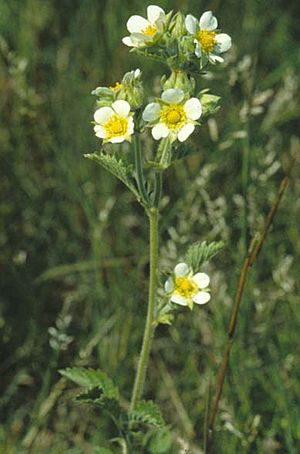Tall cinquefoil facts for kids
Quick facts for kids Tall cinquefoil |
|
|---|---|
 |
|
| Scientific classification | |
| Genus: |
Drymocallis
|
| Species: |
arguta
|
| Synonyms | |
|
Potentilla arguta Pursh |
|
Drymocallis arguta, often called the tall cinquefoil or prairie cinquefoil, is a wild plant found in North America. It is a perennial herbaceous plant, which means it lives for many years and has soft stems. This plant used to be part of the Potentilla group, but now it has its own genus, Drymocallis.
Contents
What the Plant Looks Like
Leaves and Stems
The leaves of the tall cinquefoil are special. They are called pinnately compound because they look like a feather. Each leaf has many smaller parts called leaflets, usually 7 to 11 of them. Most of these leaves grow in a circle close to the ground, forming a shape called a rosette. Some leaves also grow along the tall stem that holds the flowers. These leaves are covered in tiny, slightly sticky hairs called trichomes.
Flowers
The flowers grow in a tight group called a cyme at the top of a long stem. This stem can be from 30 to 100 cm (12 to 40 in) tall. The flowers look a bit like tiny strawberries. Each flower has five white or cream-colored petals. Between the petals are five green, pointed parts called sepals. In the very center of the flower, you'll see a round head of pistils. Around these pistils, there are more than 20 stamens, which are like tiny stalks with pollen. The plant makes a sweet liquid called nectar in a ring below the pistils.
How Insects Help
The flowers are small, and their nectar and pollen are easy for small insects to reach. Bees with short tongues often visit these flowers to collect pollen and nectar. Hoverflies also come to eat the pollen. Sometimes, wasps will visit to drink the nectar.
Seeds
After the flowers are pollinated, the pistils grow into many small, brown seeds. These seeds are held inside a cup made from the dried-up sepals of the flower.
Roots
The plant has a main, deep root called a taproot. It also has short underground stems called rhizomes near the surface. These rhizomes help the plant grow in tight groups or clumps.
A Special Ability: Protocarnivorous Plant?
Drymocallis arguta might be a protocarnivorous plant. This means it might be starting to become a meat-eating plant, but it's not fully carnivorous yet. In 1999, scientists did an experiment in the Pacific Northwest. They wanted to see if the plant could digest proteins, which is what true carnivorous plants do.
They put a special protein, marked with a tiny amount of a chemical, onto the sticky hairs of D. arguta. The plant seemed to be able to break down and take in this protein. This suggests it might produce special chemicals called protease enzymes that can digest small insects that get stuck on its sticky hairs. However, scientists are still studying this. They are not sure if the plant itself makes these chemicals, or if tiny living things on the plant's surface do.
See also
 In Spanish: Potentilla arguta para niños
In Spanish: Potentilla arguta para niños

